low beam GMC YUKON DENALI 2003 Owners Manual
[x] Cancel search | Manufacturer: GMC, Model Year: 2003, Model line: YUKON DENALI, Model: GMC YUKON DENALI 2003Pages: 447, PDF Size: 21.97 MB
Page 150 of 447
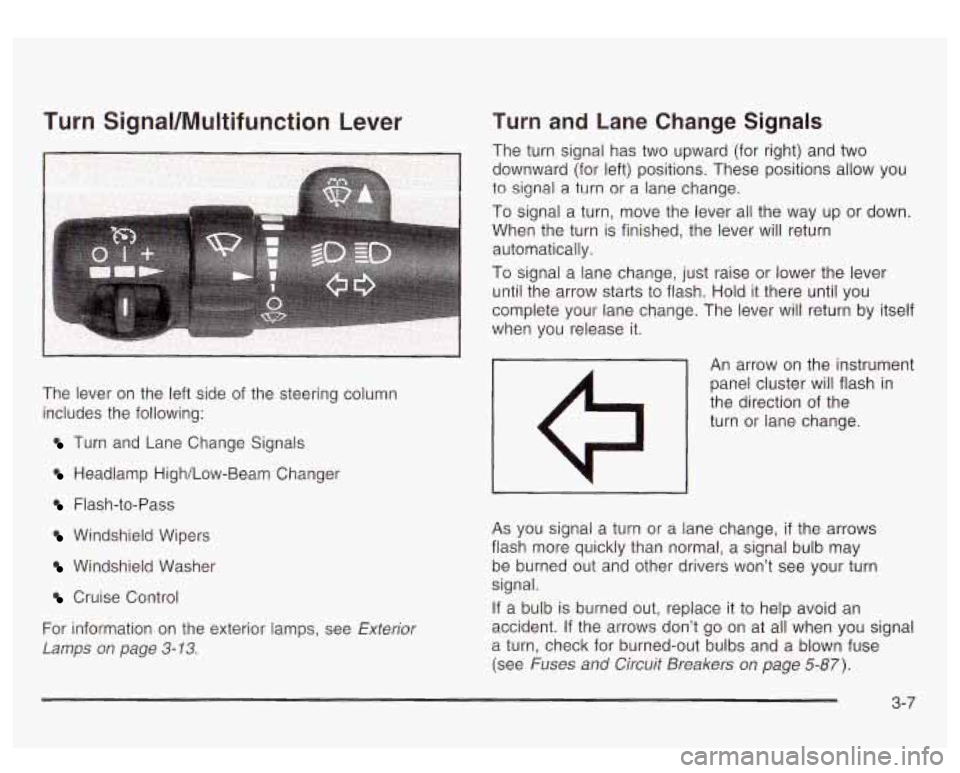
Turn SignaVMultifunction Lever
The lever on the left side of the steering column
includes the following:
Turn and Lane Change Signals
Headlamp High/Low-Beam Changer
Flash-to-Pass
Windshield Wipers
Windshield Washer
Cruise Control
For information on the exterior lamps, see Exterior
Lamps
on page 3-13.
Turn and Lane Change Signals
The turn signal has two upward (for right) and two
downward (for left) positions. These positions allow you
to signal a turn or a lane change.
To signal a turn, move the lever all the way up or down.
When the turn is finished, the lever will return automatically.
To signal a lane change, just raise
or lower the lever
until the arrow starts to flash. Hold it there until you
complete your lane change. The lever will return by itself
when you release it.
An arrow on the instrument
panel cluster will flash in
the direction of the
turn or lane change.
As you signal a turn or a lane change, if the arrows
flash more quickly than normal, a signal bulb may be burned out and other drivers won’t see your turn
signal.
If a bulb is burned out, replace it to help avoid an
accident. If the arrows don’t go on at all when you signal
a turn, check for burned-out bulbs and a blown fuse
(see Fuses
and Circuit Breakers on page 5-87).
3-7
Page 151 of 447
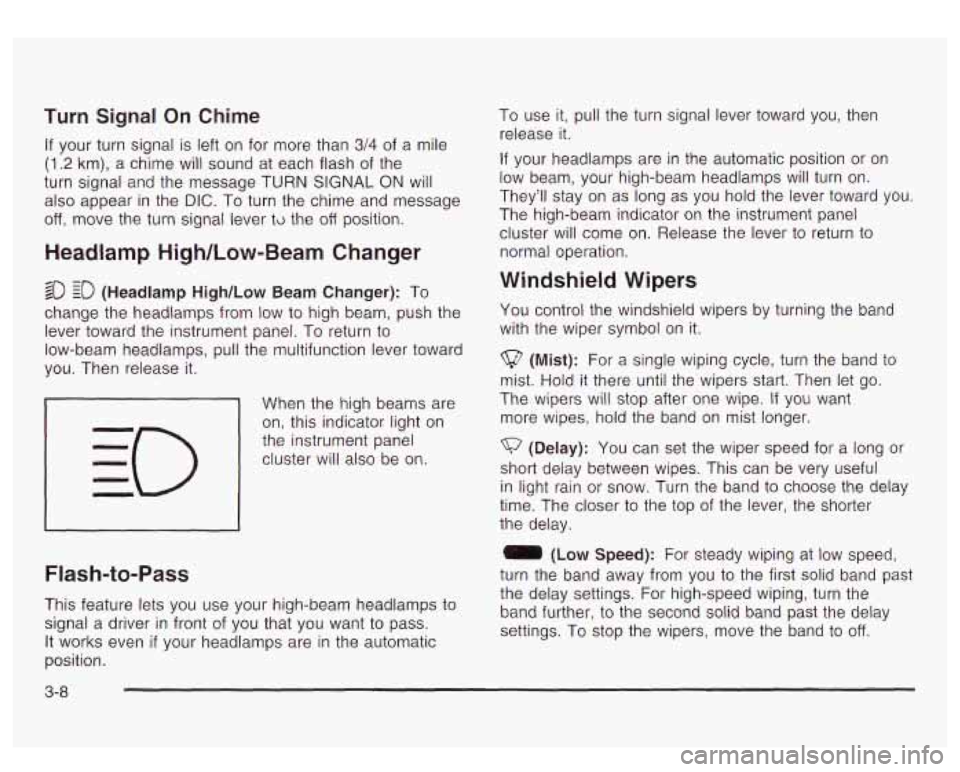
Turn Signal On Chime
If your turn signal is left on for more than 3/4 of a mile
(1.2 km), a chime will sound at each flash of the
turn signal and the message TURN SIGNAL ON will
also appear in the
DIC. To turn the chime and message
off, move the turn signal lever td the off position.
Headlamp High/Low-Beam Changer
$0 io (Headlamp High/Low Beam Changer): To
change the headlamps from low
to high beam, push the
lever toward the instrument panel. To return
to
low-beam headlamps, pull the multifunction lever toward
you. Then release
it.
When the high beams are
on, this indicator light on
the instrument panel
cluster will also be on.
I I
Flash-to-Pass
This feature lets you use your high-beam headlamps to
signal a driver in front of you that you want to pass.
It works even if your headlamps are in the automatic
position. To
use it, pull the turn signal lever toward you, then
release it.
If your headlamps are in the automatic position or on
low beam, your high-beam headlamps will turn on.
They’ll stay on
as long as you hold the lever toward you.
The high-beam indicator
on the instrument panel
cluster will come on. Release the lever
to return to
normal operation.
Windshield Wipers
You control the windshield wipers by turning the band
with the wiper symbol on it.
(Mist): For a single wiping cycle, turn the band to
mist. Hold it there until the wipers start. Then let go.
The wipers will stop after one wipe.
If you want
more wipes, hold the band on mist longer.
(Delay): You can set the wiper speed for a long or
short delay between wipes. This can be very useful
in light rain or snow. Turn the band to choose the delay
time. The closer
to the top of the lever, the shorter
the delay.
0 (Low Speed): For steady wiping at low speed,
turn the band away from you
to the first solid band past
the delay settings. For high-speed wiping, turn the
band further, to the second solid band past the delay
settings. To stop the wipers, move the band
to off.
3-8
Page 156 of 447
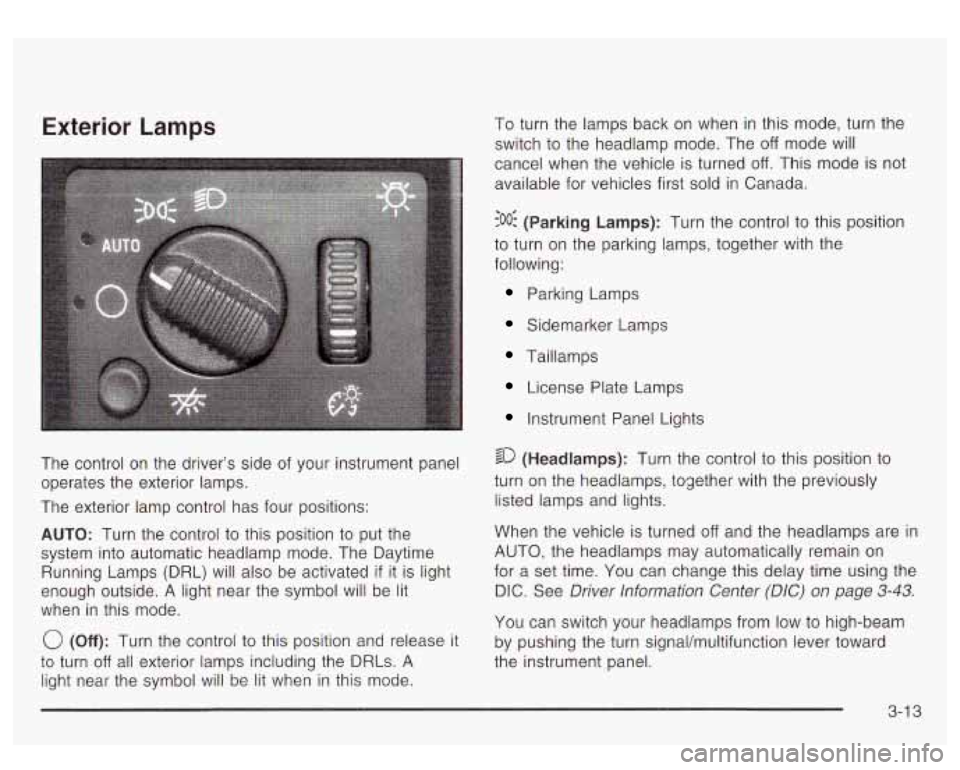
Exterior Lamps
The control on the driver’s side of your instrument panel
operates the exterior lamps.
The exterior lamp control has four positions:
AUTO: Turn the control to this position to put the
system into automatic headlamp mode. The Daytime
Running Lamps (DRL) will also be activated
if it is light
enough outside.
A light near the symbol will be lit
when in this mode.
0 (Off): Turn the control to this position and release it
to turn
off all exterior lamps including the DRLs. A
light near the symbol will be lit when in this mode.
To turn the lamps back on when in this mode, turn the
switch to the headlamp mode. The
off mode will
cancel when the vehicle is turned
off. This mode is not
available for vehicles first sold in Canada.
:oo: (Parking Lamps): Turn the control to this position
to turn on the parking lamps, together with the
following:
Parking Lamps
Sidemarker Lamps
Taillamps
License Plate Lamps
Instrument Panel Lights
$0 (Headlamps): Turn the control to this position to
turn
on the headlamps, together with the previously
listed lamps and lights.
When the vehicle is turned
off and the headlamps are in
AUTO, the headlamps may automatically remain on
for a set time. You can change this delay time using the
DIC. See Driver hformation Center
(DIC) on page 3-43.
You can switch your headlamps from low to high-beam
by pushing the turn signaVmultifunction lever toward
the instrument panel.
3-1 3
Page 158 of 447
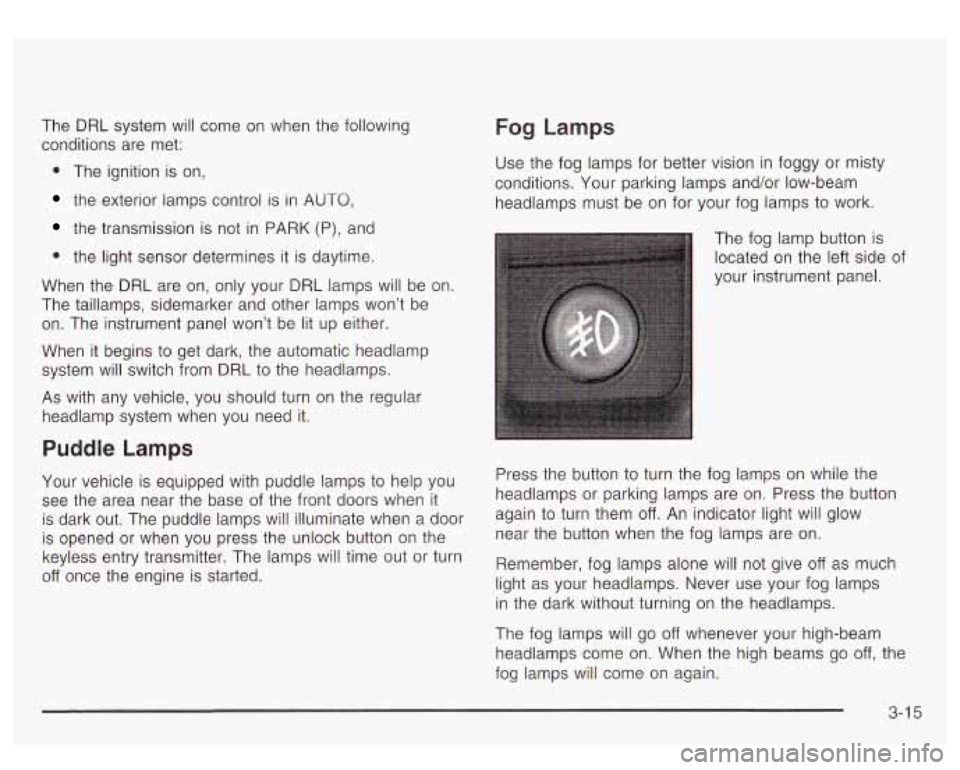
The DRL system will come on when the following
conditions are met:
0 The ignition is on,
the exterior lamps control is in AUTO,
the transmission is not in PARK (P), and
0 the light sensor determines it is daytime.
When the DRL are on, only your DRL lamps will be on
The taillamps, sidemarker and other lamps won’t be
on. The instrument panel won’t be
lit up either.
When it begins
to get dark, the automatic headlamp
system will switch from DRL
to the headlamps.
As with any vehicle, you should turn on the regular
headlamp system when you need it.
Puddle Lamps
Your vehicle is equipped with puddle lamps to help you
see the area near the base of the front doors when
it
is dark out. The puddle lamps will illuminate when a door
is opened or when you press the unlock button on the
keyless entry transmitter. The lamps will time out or turn
off once the engine is started.
Fog Lamps
Use the fog lamps for better vision in foggy or misty
conditions. Your parking lamps and/or low-beam
headlamps must be on for your fog lamps
to work.
The fog lamp button
is
located on the left side of
your instrument panel.
Press the button
to turn the fog lamps on while the
headlamps or parking lamps are on. Press the button
again to turn them
off. An indicator light will glow
near the button when the fog lamps are on.
Remember, fog lamps alone will not give
off as much
light as your headlamps. Never use your fog lamps
in the dark without turning on the headlamps.
The fog lamps will go
off whenever your high-beam
headlamps come on. When the high beams go
off, the
fog lamps will come on again.
3-1 5
Page 262 of 447
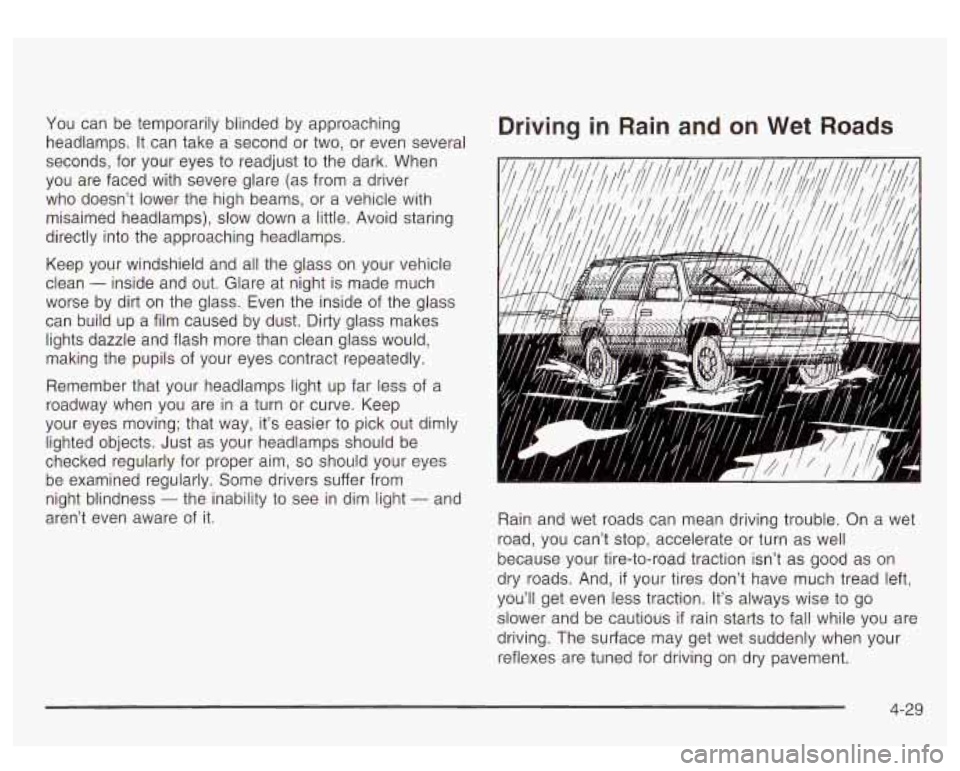
You can be temporarily blinded by approaching
headlamps.
It can take a second or two, or even several
seconds, for your eyes
to readjust to the dark. When
you are faced with severe glare (as from a driver
who doesn’t lower the high beams, or a vehicle with
misaimed headlamps),
slow down a little. Avoid staring
directly into the approaching headlamps.
Keep your windshield and all the glass on your vehicle
clean
- inside and out. Glare at night is made much
worse by dirt on the glass. Even the inside of the glass
can build up a film caused by dust. Dirty glass makes
lights dazzle and flash more than clean glass would,
making the pupils of your eyes contract repeatedly.
Remember that your headlamps light up far less of a
roadway when you are in a turn or curve. Keep
your eyes moving; that way, it’s easier
to pick out dimly
lighted objects.
Just as your headlamps should be
checked regularly for proper aim,
so should your eyes
be examined regularly. Some drivers suffer from
night blindness
- the inability to see in dim light - and
aren’t even aware of it.
Driving in Rain and on Wet Roads
Rain and wet roads can mean driving trouble. On a wet
road, you can’t stop, accelerate or turn
as well
because your tire-to-road traction isn’t as good as on
dry roads. And,
if your tires don’t have much tread left,
you’ll get even less traction.
It’s always wise to go
slower and be cautious
if rain starts to fall while you are
driving. The surface may get wet suddenly when your
reflexes are tuned for driving on dry pavement.
4-29
Page 264 of 447
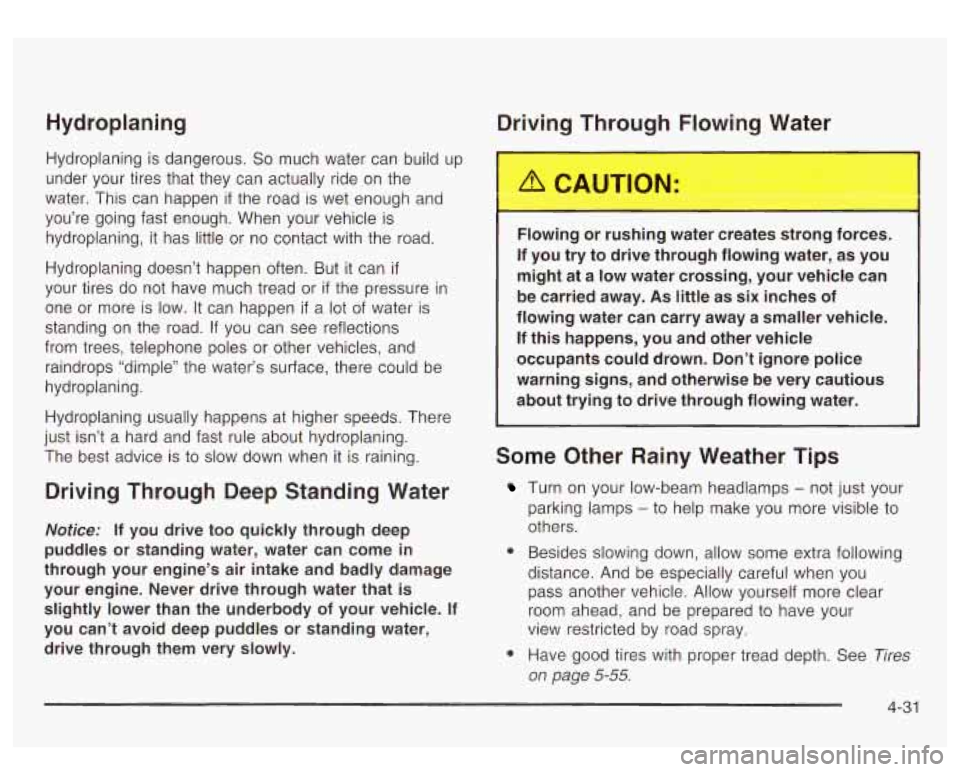
Hydroplaning
Hydroplaning is dangerous. So much water can build up
under your tires that they can actually ride on the
water. This can happen
if the road is wet enough and
you’re going fast enough. When your vehicle is
hydroplaning, it has little or no contact with the road.
Hydroplaning doesn’t happen often. But it can
if
your tires do not have much tread or if the pressure in
one or more is low. It can happen
if a lot of water is
standing on the road. If you can see reflections
from trees, telephone poles or other vehicles, and
raindrops “dimple” the water’s surface, there could be
hydroplaning.
Hydroplaning usually happens at higher speeds. There
just isn’t a hard and fast rule about hydroplaning.
The best advice is to slow down when
it is raining.
Driving Through Deep Standing Water
Notice: If you drive too quickly through deep
puddles or standing water, water can come
in
through your engine’s air intake and badly damage
your engine. Never drive through water that
is
slightly lower than the underbody of your vehicle. If
you can’t avoid deep puddles or standing water,
drive through them very slowly.
Drivhg Through Flowing Water
~~
I
Flowing or rushing water creates strong forces.
If you try to drive through flowing water, as you
might at a low water crossing, your vehicle can
be carried away.
As little as six inches of
flowing water can carry away a smaller vehicle.
If this happens, you and other vehicle
occupants could drown. Don’t ignore police
warning signs, and otherwise be very cautious
about trying to drive through flowing water.
Some Other Rainy Weather Tips
Turn on your low-beam headlamps - not just your
parking lamps
- to help make you more visible to
others.
* Besides slowing down, allow some extra following
distance. And be especially careful when you
pass another vehicle. Allow yourself more clear
room ahead, and be prepared to have your
view restricted by road spray.
* Have good tires with proper tread depth. See Tires
on page 5-55.
4-31
Page 339 of 447
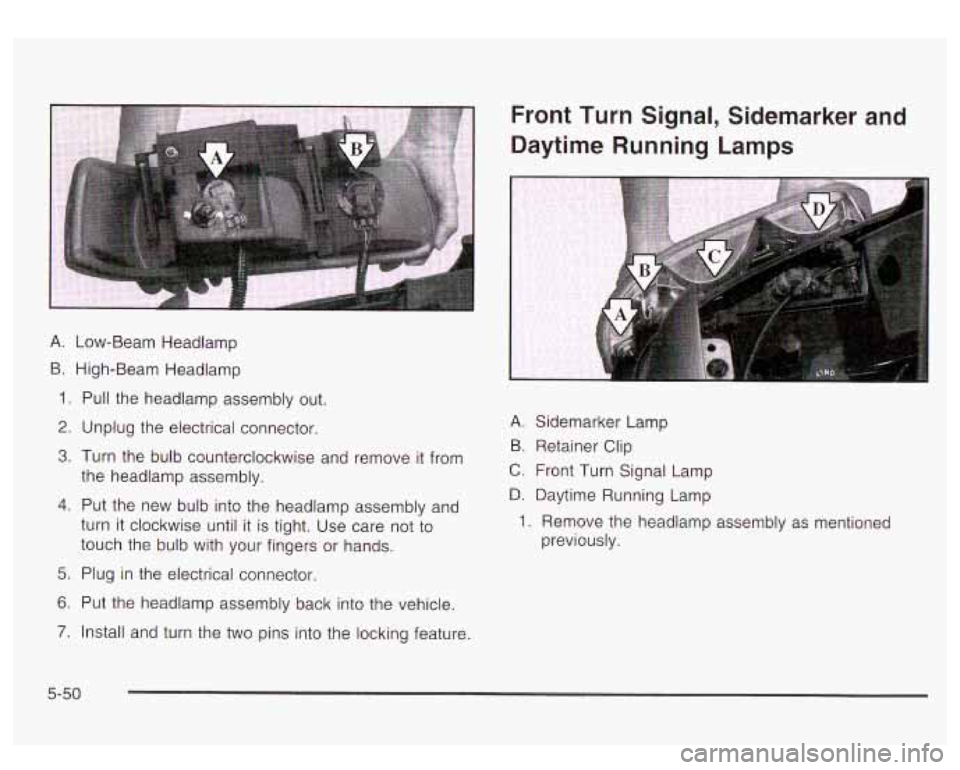
A. Low-Beam Headlamp
B. High-Beam Headlamp
1. Pull the headlamp assembly out.
2. Unplug the electrical connector.
3. Turn the bulb counterclockwise and remove it from
the headlamp assembly.
4. Put the new bulb into the headlamp assembly and
turn it clockwise until it is tight. Use care not to
touch the bulb with your fingers or hands.
5. Plug in the electrical connector.
6. Put the headlamp assembly back into the vehicle.
7. Install and turn the two pins into the locking feature.
A. Sidemarker Lamp
B. Retainer Clip
C. Front Turn Signal Lamp
D. Daytime Running Lamp
1. Remove the headlamp assembly as mentioned
previously.
5-50
Page 383 of 447
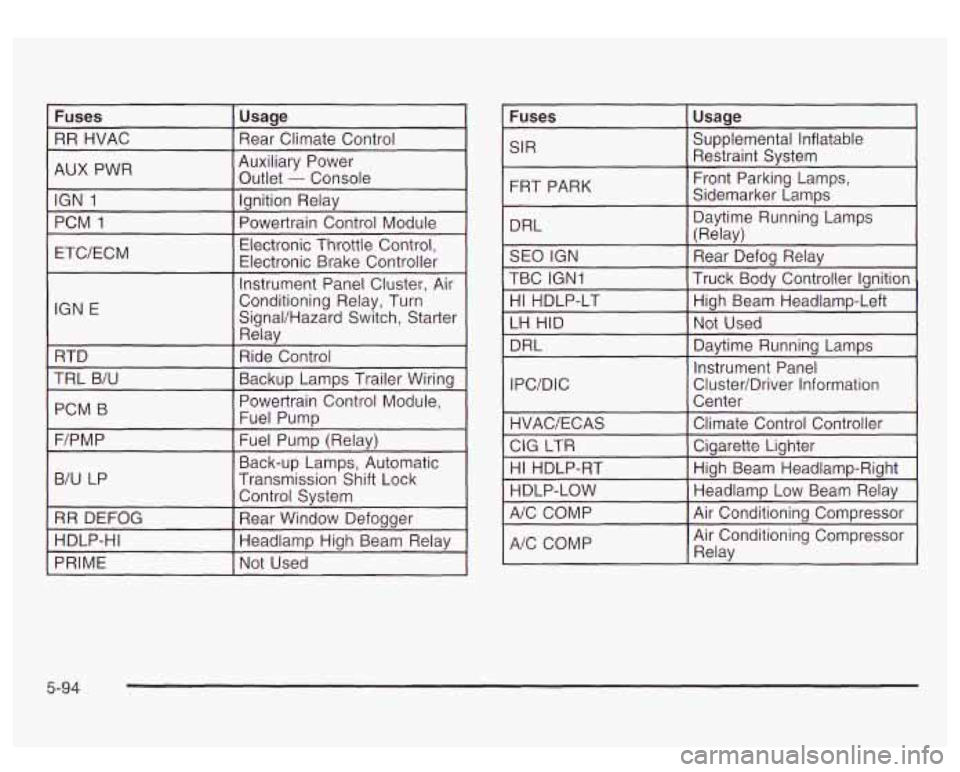
Fuses
RR HVAC
Usage
Rear Climate Control
AUX PWR I
Auxiliary Power
Outlet
- Console
IGN
1
PCM 1 Ignition Relay
Electronic Throttle Control,
ETC/ECM Powertrain Control Module
Electronic Brake Controller
IGN E Instrument Panel Cluster,
Air
Conditioning Relay, Turn
SignaVHazard Switch, Starter
Relav
RTD I Ride Control I
TRL B/U
~~
I Backup LampsTrailG Wiring 1
PCM B I
Powertrain Control Module,
Fuel Pumr,
I I
F/PMP I Fuel Pump (Relay)
B/U LP
I
Back-up Lamps, Automatic
Transmission Shift Lock
I
Control System
RR DEFOG
Rear Window Defoaaer
HDLP-HI
~~~ ____
HeadlampHighBeam Relay
PRIME Not Used
Fuses I Usage I
SIR Supplemental Inflatable
Restraint System
FRT PARK
DRL Front Parking Lamps,
Sidemarker Lamps
Daytime Running Lamps
(Relav)
SEO IGN
Truck Body Controller Ignition
TBC IGN1 Rear
Defog Relay
HI HDLP-LT High
Beam Headlamp-Left
LH HID Not
Used
DRL
I Davtime Runnina LamDs I
Instrument Panel
IPC/DIC Cluster/Driver Information
HI HDLP-RT
HDLP-LOW High
Beam Headlamp-Right
Headlamp Low Beam Relav
A/C COMP
I Air Conditionina Comm-essor I v
A/C COMP Air
Conditioning Compressor
Relav
5-94
Page 431 of 447
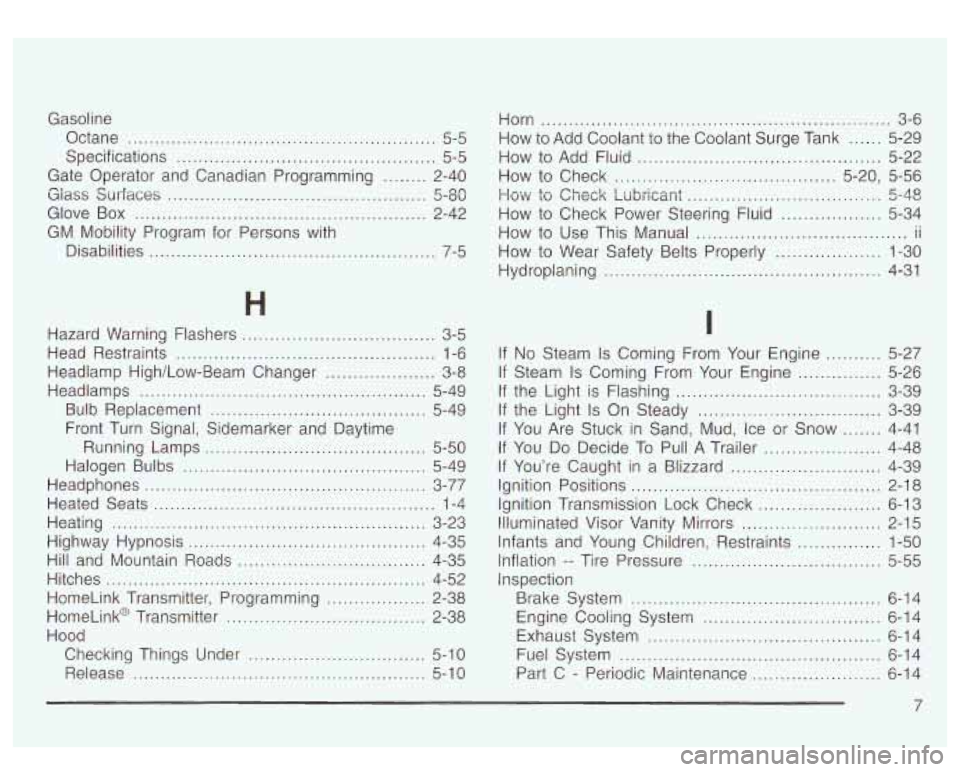
Gasoline Octane
........................................................ 5-5
Gate Operator and Canadian Programming ........ 2-40
Glass surfaces 3-o~
Glove Box ..................................................... 2-42
GM Mobility Program for Persons with
Disabilities
................................... 7-5
Specifications ............................................... 5-5
rn r nn ...............................................
H
Hazard Warning Flashers ............................... 3-5
Head Restraints
........................................... 1-6
Headlamp High/Low-Beam Changer
.................... 3-8
Headlamps
.................................................... 5-49
Bulb Replacement
....................................... 5-49
Front Turn Signal, Sidemarker and Daytime
Running Lamps
........................................ 5-50
Halogen Bulbs ............................................ 5-49
Headphones
................................................... 3-77
Heated Seats
................................................... 1-4
Heating
......................................................... 3-23
Highway Hypnosis
........................................... 4-35
Hill and Mountain Roads
.................................. 4-35
Hitches
.......................................................... 4-52
HomeLink Transmitter, Programming
.................. 2-38
HomeLinkO Transmitter
............................ 2-38
Hood Checking Things Under
................................ 5-10
Release
..................................................... 5-1 0
Horn ............................................................... 3-6
How
to Add Coolant to the Coolant Surge Tank ...... 5-29
How
to Add Fluid ............................................ 5-22
How
to Check ........................................ 5-20, 5-56
How to Check Lhrizzri-it ................................... 5-48
How
to Check Power Steering Fluid .................. 5-34
How
to Use This Manual ...................................... ii
How to Wear Safety Belts Properly ................... 1-30
Hydroplaning
.................................................. 4-31
I
If No Steam Is Coming From Your Engine .......... 5-27
If Steam Is Coming From Your Engine ............... 5-26
If the Light is Flashing
..................................... 3-39
If the Light Is On Steady ................................. 3-39
If You Are Stuck in Sand, Mud, Ice or Snow
....... 4-41
If You Do Decide To Pull
A Trailer ..................... 4-48
If You’re Caught in a Blizzard
........................... 4-39
Ignition Positions
............................................. 2-18
Ignition Transmission Lock Check
...................... 6-13
Illuminated Visor Vanity Mirrors
......................... 2-15
Infants and Young Children, Restraints
............... 1-50
Inflation -- Tire Pressure ..................... ..... 5-55
Inspection
Brake System
............................................. 6-14
Engine Cooling System
................................ 6-14
Exhaust System
.......................................... 6-14
Fuel System
............................................... 6-14
Part C
- Periodic Maintenance ....................... 6-14
7